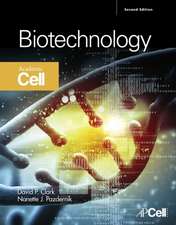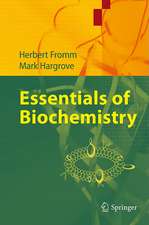Lipids and Lipid Polymers in Higher Plants
Editat de M. Tevini, H.K. Lichtenthaleren Limba Engleză Paperback – 6 dec 2011
Preț: 644.18 lei
Preț vechi: 757.85 lei
-15% Nou
Puncte Express: 966
Preț estimativ în valută:
123.26€ • 129.04$ • 101.99£
123.26€ • 129.04$ • 101.99£
Carte tipărită la comandă
Livrare economică 07-21 aprilie
Preluare comenzi: 021 569.72.76
Specificații
ISBN-13: 9783642666346
ISBN-10: 3642666345
Pagini: 328
Ilustrații: XIV, 310 p.
Dimensiuni: 170 x 244 x 17 mm
Greutate: 0.52 kg
Ediția:Softcover reprint of the original 1st ed. 1977
Editura: Springer Berlin, Heidelberg
Colecția Springer
Locul publicării:Berlin, Heidelberg, Germany
ISBN-10: 3642666345
Pagini: 328
Ilustrații: XIV, 310 p.
Dimensiuni: 170 x 244 x 17 mm
Greutate: 0.52 kg
Ediția:Softcover reprint of the original 1st ed. 1977
Editura: Springer Berlin, Heidelberg
Colecția Springer
Locul publicării:Berlin, Heidelberg, Germany
Public țintă
ResearchDescriere
This book contains a number of papers dealing with the main topics of a Symposium on "Lipids and Lipid Polymers in Higher Plants", held in July 1976 at the Botanical Institute of the University of Karlsruhe. The symposium was organized by Professors E. Heinz, H.K. Lichtenthaler, H.K. Mangold, and M. Tevini. The sponsorship by the Deutsche Forschungsgemeinschaft and the Erwin-Riesch-Stiftung is gratefully acknowledged. The intention of the Symposium was to bring together in one place scientists working in very different fields of plant lipids, such as fatty acids, glycolipids, phospholipids, prenyllipids, sterols, and lipid polymers. The emphasis was placed on biosynthesis, distribution, function, and physiology of the various higher plant lipids and their role in biomembranes and epidermal cell walls. By combining the major contributions in this book, we hope to give all plant scientists access to the recent developments in biochemistry and physiology of plant lipid metabolism. The editors are very grateful to the contributors, who have taken great care to present up-to-date reviews. Karlsruhe, May 1977 M. TEVINI H.K. LICHTENTHALER Contents Section 1. Function, Organization and Lipid Composition of Biomembranes Chapter 1. Functional Organization of Biomembranes P. SITTE (With 15 Figures) A. Introduction. . . . . 1 B. Membrane Functions . 2 I. Membrane Diversity 2 II. Membranes as Barriers 4 III. Lipids and Permeability . 5 IV. Specific Transport . . . 8 V. Membrane Flow and Membrane Families 9 VI. General Principles of Cellular Compartmentation 10 C. Membrane Biogenesis. . . . . . . . . . . . .
Cuprins
Section 1. Function, Organization and Lipid Composition of Biomembranes.- 1 Functional Organization of Biomembranes.- A. Introduction.- B. Membrane Functions.- I. Membrane Diversity.- II. Membranes as Barriers.- III. Lipids and Permeability.- IV. Specific Transport.- V. Membrane Flow and Membrane Families.- VI. General Principles of Cellular Compartmentation.- C. Membrane Biogenesis.- D. Intracellular Membranes and Their Compartments.- E. The Role of Lipid Self-Assembly.- F. The Molecular Architecture of Elementary Membranes.- G. Conventional Electron Microscopy of Biomembranes.- References.- 2 The Prenyllipids of the Membranes of Higher Plants.- A. Introduction.- B. Localization.- I. Intracellular Distribution.- II. Intraorganelle Distribution.- C. Localization of Biosynthesis.- I. General Pattern of Synthesis.- II. Synthesis in the Chloroplast.- 1. Formation of Acetyl-CoA.- 2. Formation of Mevalonic Acid.- 3. Conversion of MVA into Carotenoids.- 4. Formation of Mixed Terpenoids.- a) General.- b) Tocopherols.- D. Regulation of Prenyllipid Synthesis.- I. Terpenes.- References.- 3 Glyco- and Phospholipids of Biomembranes in Higher Plants.- A. Introduction.- B. Lipid Composition of Plant Biomembranes.- I. Plasmalemma.- II. Mitochondria.- III. Chloroplasts.- IV. Glyoxysomes and Peroxisomes.- V. Microsomes.- VI. Nuclei.- VII. Comparisons Between Different Membranes.- C. Biosynthesis of Membrane Lipids.- D. Lipid Exchanges Between Cell Organelles.- E. Role of the Lipid Environment in the Activities of Membrane-Bound Enzymes.- F. Conclusions.- References.- Section 2 Physiology and Biochemistry of Fatty Acids and Glycerides.- 4 Lipid Biosynthesis in Developing Seeds.- A. Introduction.- B. General Considerations.- C. The Role of the Leaf Compartment.- D. The Developing Soybean Seed.- I. General Considerations.- II. Comparison of Capacities of Developing Tissues to Incorporate.- 14C-Acetate into Long-Chain Fatty Acids.- III. Localization of Enzymes Involved in Fatty Acid Biosynthesis.- E. Conclusions.- References.- 5 The Cyclopentenyl Fatty Acids.- A. Introduction.- B. Chemistry of Cyclopentenyl Fatty Acids.- I. Isolation, Characterization, Synthesis.- II. Fatty Acids in Flacourtiaceae.- 1. Methods of Analysis.- 2. Preparative Methods.- 3. Compositional and Structural Studies.- 4. New Cyclopentenyl Fatty Acids.- C. Biochemistry of Cyclopentenyl Fatty Acids.- I. Biosynthesis.- 1. Aleprolic Acid as Precursor.- 2. Cyclopentenylglycine as Precursor.- II. Metabolism.- D. Conclusions.- References.- 6 Enzymatic Reactions in Galactolipid Biosynthesis.- A. Introduction.- B. Acyl-CoA and Acyl-ACP Thioesters.- C. sn-Glycerol 3-Phosphate.- D. UDP-Galactose.- E. Acylation of Glycerol Phosphate.- F. Diglycerides.- G. Galactosyltransferases.- H. Fatty Acid Specificities in Galactolipids.- I. Radioactive Labeling of Galactolipids in vivo.- References.- 7 Light, Function and Lipids During Plastid Development.- A. Introduction.- B. Light and Plastid Structure During Greening.- I. General Remarks.- II. The Prolamellar Body.- III. Thylakoid Formation.- IV. Light Regulation.- C. Light and Lipids.- I. General Remarks.- II. Lipids in Plastids and Plastid Fractions.- III. Formation of Glycerolipids During Development.- IV. Formation of Fatty Acid.- V. Light Regulation of Glycerolipid Metabolism.- D. Light and Function.- I. General Remarks.- IL Chlorophylls.- III. Photosynthetic Activity.- IV. Light Regulation.- E. Final Remarks.- References.- Section 3 Physiology and Biochemistry of Plant Steroids.- 8 The Biosynthesis of Plant Sterols.- A. Introduction.- B. Structure and Distribution.- C. Squalene Formation and Cyclisation.- D. Sterol Side-Chain Formation.- E. Ring Structure Modification in Phytosterol Formation.- F. Conclusions.- References.- 9 Steryl Glycosides and Acylated Steryl Glycosides.- A. Introduction.- B. Structure and Distribution.- C. Biosynthesis.- I. Glycosylation.- II. Acylation.- III. Intracellular Localization.- D. Metabolism.- E. Possible Functions.- F. Conclusions.- References.- Section 4 Physiology and Biochemistry of Prenyllipids.- 10. The Biosynthesis and Biological Significance of Prenols and Their Phosphorylated Derivatives.- A. Biosynthesis.- I. General.- II. a. Formation of Isopentenyl Pyrophosphate from Acetyl-CoA.- II. b. Subcellular Distribution of the Pathway from Acetyl-CoA to Isopentenyl Pyrophosphate.- III. a. Monoterpenes—Formation.- III. b. Different Pools of Soluble Precursors.- IV. Sesquiterpenes—Formation.- V. Diterpenes — Formation.- VI. Polyterpenes — Formation.- VII. Stereochemistry of the Substituted Double Bond in Polyprenols.- 1. General.- 2. Stereochemistry of the ?-Isoprene Residue of Mono- and Sesquiterpenes.- VIII. Phosphorylation of Prenols.- IX. Control of the Rate of Biosynthesis.- 1. General.- 2. Compartmentation of Early Steps.- 3. Key Enzymes?.- 4. Hormonal.- 5. Light Effects.- 6. Compartmentation of Polyisoprenoid Biosynthesis.- B. Function of Isoprenoid Alcohols and Their Phosphates.- I. A Precursor Role.- II. A Role in Glycosylation.- References.- 11 Carotenoids in Higher Plants.- A. Nomenclature.- B. Distribution.- I. Photosynthetic Tissues.- II. Fruits.- III. Flowers.- IV. Other Tissues.- C. Formation.- I. Early Steps.- II. Formation of 15-Cis-Phytoene.- III. Carotene Desaturation.- IV. Carotene Cyclization.- V. Xanthophyll Formation.- VI. Factors Affecting Carotenoid Formation.- D. Function.- E. Appendix.- Trivial and Semi-systematic Names and Structures of Some Higher Plant.- Carotenoids.- References.- 12 The Xanthophyll Cycle in Higher Plants.- A. Introduction.- B. General Characteristics of the Xanthophyll Cycle.- C. The De-epoxidation Pathway.- I. The Cosubstrates of De-epoxidation.- II. The De-epoxidase.- D. The Epoxidation Pathway.- I. The Cosubstrates of Epoxidation.- II. The Epoxidase.- E. A Transmembrane Model of the Xanthophyll Cycle.- F. The Control of the Xanthophyll Cycle by Light.- G. Hypothesis on the Function of the Xanthophyll Cycle.- References.- 13 Regulation of Prenylquinone Synthesis in Higher Plants.- A. Introduction.- B. Function of Prenylquinones -.- C. Biosynthesis of Prenylquinones.- D. Site of Synthesis of Prenylquinones and Chromanols in the Plant Cell.- E. Regulation of Light-induced Prenylquinone Synthesis by Phytochrome Pfr.- F. Regulation of Lipoquinone Synthesis by Blue and Red Light.- G. Influence of Phytohormones on Lipoquinone Metabolism and Photosynthetic Activity.- H. Formation of Excess Prenylquinones.- I. Stimulation of Prenylquinone Synthesis by Supplying Additional Aromatic Compounds.- J. Turnover of Prenylquinones.- K. Regulation of Prenylquinone Synthesis by Herbicides.- L. Formation of Prenylquinones in Plant Tissue Cultures.- M. Conclusions.- References.- 14 Chlorophyll Formation: The Phytylation Step.- A. Introduction.- B. Biosynthetic Pathways for the Different Protochlorophyll Forms to Chlorophyll a.- C. The Occurrence of the Two Forms of Protochlorophyll Pigments in Dark-grown Plants and Their Photoreduction.- D. The Esterification of Chlorophyllide a.- E. Light-induced Changes in the Rate of the Esterification Reaction.- F. Biosynthesis of Esterifying Prenols.- G. The Pools of Free Phytol and Phytol Bound as Acyl Esters During Greening.- References.- Section 5 Lipid Polymers in Higher Plants.- 15 Biosynthesis and Degradation of Lipid Polymers.- A. Introduction.- B. Biosynthesis of Cutin.- I. Biosynthesis of the C16 Family of Cutin Acids.- 1. In vivo Studies.- 2. Enzymatic Synthesis of the C16 Family of Cutin Acids.- a) ?-Hydroxylation.- b) In-Chain Hydroxylation.- II. Biosynthesis of the C18 Family of Cutin Acids.- 1. In vivo Experiments.- 2. Enzymatic Synthesis of the C18 Family of Cutin Acids.- a) Epoxidation.- b) Epoxide Hydration.- III. Synthesis of Cutin from Monomers.- C. Biosynthesis of Suberin.- I. Experiments with Tissue Slices.- II. Experiments with Cell-Free Preparations.- D. Degradation of Lipid Polymers.- I. Degradation by Plants.- II. Degradation by Microorganisms.- 1. Isolation and Characterization of Cutinases.- 2. Characterization of Cutinases as Glycoproteins.- III. Degradation by Animals.- E. Conclusions.- References.- 16 The Intermolecular Structure of Some Plant Cutins.- References.













